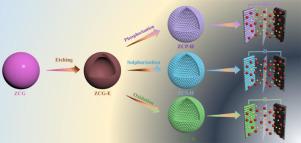Applied Materials Today ( IF 7.2 ) Pub Date : 2020-06-01 , DOI: 10.1016/j.apmt.2020.100698 Sarmad Iqbal , Umer Javed , Jae-Jin Shim , Amr Hussein Mady , Abdelrehman M. Rabie , Saad G. Mohamed

|
Developing next-generation advanced electrode materials by tailoring the structural properties may provide a feasible pathway to enhance the electrochemical functions of energy storage devices. In this study, the rational strategy to construct hollow spheres of zinc cobalt phosphide through etching of zinc cobalt-glycolate followed by phosphorization method is presented. This method involves the fabrication of non-uniform zinc-cobalt glycolate solid spheres, which consists of an unstable inner layer compared to the chemically robust outer surface. The inner layer was then etched by utilizing the services of ammonium hydroxide without destroying the original size and shape. For comparison, the resultant hollow spheres were then subjected to sulfurization and calcination process to obtain zinc cobalt sulfide and zinc cobalt oxide respectively. Benefiting from the obtained porous structure and higher electrical conductivity of the zinc cobalt phosphide was exhibited remarkable electrochemical properties. Besides, the fabricated zinc cobalt phosphide//activated carbon asymmetric capacitor produced an energy/power density of 45.7 Wh kg−1/900 W kg−1 with outstanding cycling stability of 99.3% after 5000 cycles. In comparison, the assembled zinc cobalt sulfide//activated carbon and zinc cobalt oxide//activated carbon asymmetric capacitors delivered an energy/power density of 38.4 Wh kg−1/925 W kg−1, 31.4 Wh kg−1//940 W kg−1 with a surprisingly low cycle life of 75.7% and 53.1% respectively. This insight obtained from this comprehensive work offers a new perspective for the synthesis of exceptional electrode materials for supercapacitors.
中文翻译:

通过直接蚀刻方法将双金属有机骨架结构工程化并转化为用于电化学电容器的磷化物
通过调整结构特性来开发下一代高级电极材料可能提供增强能量存储设备电化学功能的可行途径。本研究提出了一种合理的策略,即通过刻蚀乙醇酸钴锌并随后进行磷化方法来构造磷化锌钴空心球。该方法涉及非均一的乙醇酸锌钴钴固体球的制造,与化学坚固的外表面相比,它由不稳定的内层组成。然后在不破坏原始尺寸和形状的情况下,利用氢氧化铵对内层进行蚀刻。为了进行比较,然后将所得空心球进行硫化和煅烧工艺,分别得到硫化锌钴和氧化锌钴。得益于所获得的多孔结构和磷化锌钴的较高电导率,其表现出显着的电化学性能。此外,制造的磷化锌钴//活性炭非对称电容器产生的能量/功率密度为45.7 Wh kg-1 / 900 W kg -1,在5000次循环后具有99.3%的出色循环稳定性。相比较而言,组装锌钴硫化物//活性炭和锌钴氧化物//活性炭非对称电容器递送38.4瓦kg的能量/功率密度-1 / 925千克w ^ -1,31.4瓦千克-1 // 940W¯¯ kg -1的循环寿命低得令人惊讶,分别为75.7%和53.1%。从这项全面的工作中获得的见解为合成超级电容器的特殊电极材料提供了新的视角。











































 京公网安备 11010802027423号
京公网安备 11010802027423号